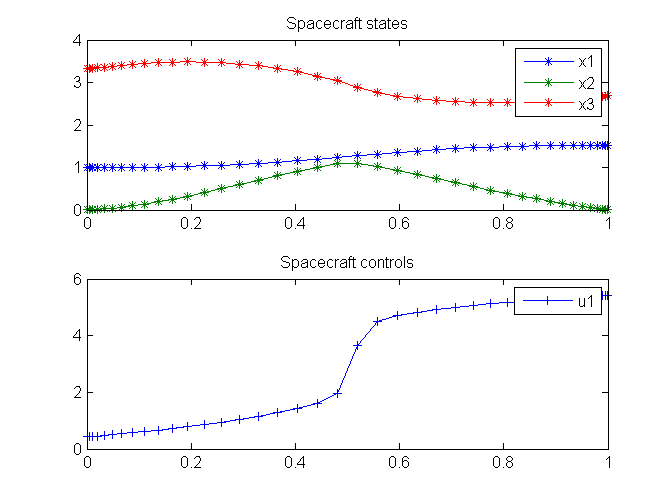PROPT Max Radius Orbit Transfer
From TomWiki
Jump to navigationJump to search
|
This page is part of the PROPT Manual. See PROPT Manual. |
Problem description
Maximum radius orbit transfer of a spacecraft.
Applied Optimal Control, Bryson & Ho, 1975. Example on pages 66-69.
Programmers: Gerard Van Willigenburg (Wageningen University) Willem De Koning (retired from Delft University of Technology)
% Copyright (c) 2009-2009 by Tomlab Optimization Inc.Problem setup
% Array with consecutive number of collocation points
narr = [20 40];
toms t;
t_f = 1; % Fixed final time
for n=narr
p = tomPhase('p', t, 0, t_f, n);
setPhase(p)
tomStates x1 x2 x3
tomControls u1
% Parameters
r0 = 1; mmu = 11; th = 1.55;
m0 = 1; rm0 = -0.25;
% Initial state
xi=[r0; 0; sqrt(mmu/r0)];
% Initial guess
if n==narr(1)
x0 = {icollocate({x1 == xi(1); x2 == xi(2); x3 == xi(3)})
collocate({u1 == 0})};
else
x0 = {icollocate({x1 == xopt1; x2 == xopt2; x3 == xopt3})
collocate({u1 == uopt1})};
end
% Boundary constraints
cbnd = {initial({x1 == xi(1); x2 == xi(2); x3 == xi(3)})
final({x3 == sqrt(mmu/x1); x2 == 0})};
% ODEs and path constraints
dx1 = x2;
dx2 = x3.*x3./x1-mmu./(x1.*x1)+th*sin(u1)./(m0+rm0*t);
dx3 = -x2.*x3./x1+th*cos(u1)./(m0+rm0*t);
ceq = collocate({
dot(x1) == dx1
dot(x2) == dx2
dot(x3) == dx3});
% Objective
objective = -final(x1);Solve the problem
options = struct;
options.name = 'Spacecraft';
solution = ezsolve(objective, {cbnd, ceq}, x0, options);
xopt1 = subs(x1,solution);
xopt2 = subs(x2,solution);
xopt3 = subs(x3,solution);
uopt1 = subs(u1,solution);Problem type appears to be: lpcon
Time for symbolic processing: 0.17673 seconds
Starting numeric solver
===== * * * =================================================================== * * *
TOMLAB - TOMLAB Development license 999007. Valid to 2011-12-31
=====================================================================================
Problem: --- 1: Spacecraft f_k -1.526286382793850200
sum(|constr|) 0.000000153661967715
f(x_k) + sum(|constr|) -1.526286229131882400
f(x_0) -0.999999999999998220
Solver: snopt. EXIT=0. INFORM=1.
SNOPT 7.2-5 NLP code
Optimality conditions satisfied
FuncEv 1 ConstrEv 75 ConJacEv 75 Iter 43 MinorIter 94
CPU time: 0.078001 sec. Elapsed time: 0.066000 sec.
Problem type appears to be: lpcon
Time for symbolic processing: 0.17837 seconds
Starting numeric solver
===== * * * =================================================================== * * *
TOMLAB - TOMLAB Development license 999007. Valid to 2011-12-31
=====================================================================================
Problem: --- 1: Spacecraft f_k -1.526020732841174300
sum(|constr|) 0.000002928423841178
f(x_k) + sum(|constr|) -1.526017804417333100
f(x_0) -1.526286382793840000
Solver: snopt. EXIT=0. INFORM=1.
SNOPT 7.2-5 NLP code
Optimality conditions satisfied
FuncEv 1 ConstrEv 15 ConJacEv 15 Iter 13 MinorIter 158
CPU time: 0.046800 sec. Elapsed time: 0.057000 sec.
end
% Get final solution
t = subs(collocate(t),solution);
x1 = subs(collocate(x1),solution);
x2 = subs(collocate(x2),solution);
x3 = subs(collocate(x3),solution);
u1 = subs(collocate(u1),solution);
%Bound u1 to [0,2pi]
u1 = rem(u1,2*pi); u1 = (u1<0)*2*pi+u1;
% Plot final solution
subplot(2,1,1)
plot(t,x1,'*-',t,x2,'*-',t,x3,'*-');
legend('x1','x2','x3');
title('Spacecraft states');
subplot(2,1,2)
plot(t,u1,'+-');
legend('u1');
title('Spacecraft controls');